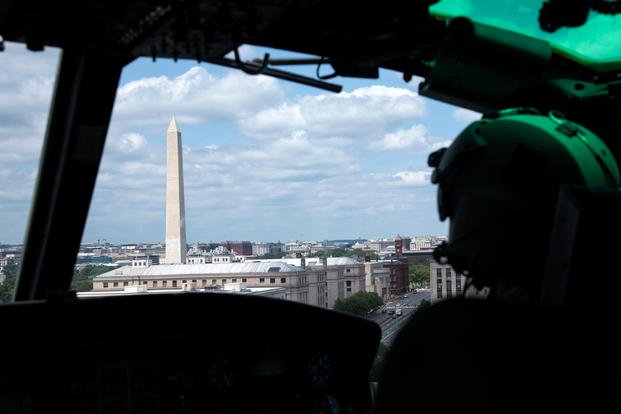Washington D.C. area residents complain that constant helicopter noise makes them feel like they're "living in a war zone," and they're right about one thing: the greatest proportion of the offending noise comes from military aircraft, according to a new study.
The Government Accountability Office was ordered to study the problem of helicopter noise over D.C. in 2019 after a spike in complaints.
In August 2020, Rep. Don Beyer, D-Va., and Delegate Eleanor Holmes Norton, D-D.C., introduced legislation that proposes centralizing complaints from area residents and would require the Defense Department and the FAA to work together to create solutions, according to a report from the Washington Post. Norton and Beyer were among six lawmakers who initially requested the study.
While thin on solutions, the new study found that many noise complaints never made their way to agencies or entities, like the military, with authority to do anything about it. Even if those complaints were all properly routed, the report notes that essential missions, like military night training flights, are unlikely to change. Still, GAO proposed that increased information sharing among agencies and chopper operators -- through a new “mechanism” created by the Office of Environment and Energy -- may help reduce noise that disturbs nearby residents.
The study found that 37% of helicopter flights in the D.C.-Maryland-Virginia region, also known as the DMV, are military flights. Medical evacuations account for nearly 21%; other aviation activity, such as charters or flight schools, roughly 16%; state and local law enforcement, 15%; federal law enforcement and emergency support, 6%; and news helicopters, nearly 5%.
GAO examined data between 2017 and 2019 and analyzed 88,000 helicopter flights within 30 miles of Ronald Reagan Washington National Airport to understand the flight patterns.
Federal Aviation Administration data indicates there was a slight decrease in flights during those years -- from 31,000 to 29,000 annually. However, "it is unknown whether there has been a change in helicopter noise in the area," the study said.
GAO says that increased information-sharing among agencies and chopper operators may help reduce noise that disturbs nearby residents.
Read Next: Air Force Brass Order Removal of All Offensive, Non-Inclusive Mottos, Patches and Emblems
"The FAA receives and responds to complaints on helicopter noise from the public through its noise ombudsman and has recently developed online forms that improve FAA's ability to identify and respond to helicopter noise issues," the study states. "FAA's and operators' approach to addressing these issues in the D.C. area is impeded because they do not consistently or fully share the information needed to do so."
Operators interviewed for the report said that the administration "has not communicated with operators about helicopter noise or forwarded complaints to them."
"Similarly, operators often receive noise complaints from the public -- some complaints are not directed to the correct operator -- but do not typically share these complaints with the FAA," the study says.
Helicopters flying near D.C. must adhere to strict regulations. According to FAA policy, they must maintain at least 500 feet of vertical separation "from large passenger aircraft while in flight in certain airspace near commercial airports."
Rotorcraft are even more limited within the D.C. area airspace, particularly near the airport and flying across the Potomac River because the aviation routes often "overlap with commercial passenger airplane operations," the study says."As a result, helicopters in these areas may fly as low as 200 feet above mean sea level."
Roughly 15% of the military's flights occur at night for training purposes. The GAO included the Coast Guard as part of these flights despite the branch falling under the Department of Homeland Security.
There are multiple military aviation hubs around the DMV. For example, the Coast Guard has Eurocopter MH-65D Dolphin helicopters stationed at Reagan; the Army and the National Guard use Sikorsky UH-60 Black Hawks and Eurocopter UH-72 Lakotas stationed at Davison Army Air Field in Fort Belvoir, Virginia; and the Air Force operates Bell UH-1 Huey helicopters out of Joint Base Andrews, Maryland.
The Marine Corps has the largest assortment of helicopters, flying Bell Boeing MV-22 Osprey tiltrotor aircraft, Sikorsky VH-3D Sea Kings and Sikorsky VH-60N White Hawks stationed at Marine Corps Air Facility Quantico, Virginia, and Joint Base Anacostia-Bolling in D.C.
The V-22s can fly to and from the Pentagon, while the VH-3D and VH-60N -- used for executive transport and known as "Marine One" when the president is aboard -- regularly fly to the White House or the Naval Observatory when the vice president is on board.
While GAO officials spoke to the services, the study does not include a breakdown of which service flies its helicopters the most. It did note affiliated events.
For example, in fall 2018, the Army began a clandestine training mission that increased use of its Black Hawk helicopters in the D.C. region. Bloomberg News reported that the service requested additional funding for the mysterious operation, including a "Sensitive Compartmented Information Facility." Weeks later, the news outlet reported the flights were part of a training assignment aimed at responding to a terrorist attack or a natural disaster.
The GAO recommended that the FAA develop means for the organization and operators to regularly share information in order to improve responses "to individual helicopter noise concerns," the report says.
The FAA has already agreed to its recommendation.
-- Oriana Pawlyk can be reached at oriana.pawlyk@military.com. Follow her on Twitter at @Oriana0214.
Related: Navy Faces Lawsuits over Expanded Growler Jet Training in Pacific
















